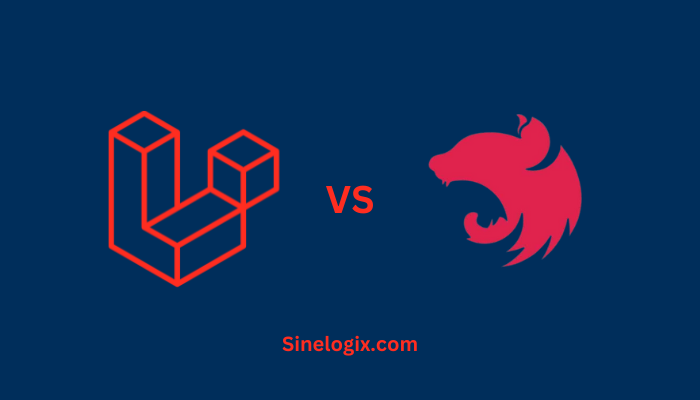Selecting the right framework for SaaS development is a critical decision that significantly influences the trajectory and success of your project.
In this comprehensive analysis, we delve into the intricacies of two powerful contenders: Laravel and NestJS. Across 20 critical aspects, we aim to provide nuanced insights that empower your decision-making process.
By the end of this exploration, you’ll be well-equipped to make an informed choice based on your project’s specific requirements.
Introduction
The landscape of web development is ever-evolving, and choosing the right framework for your Software as a Service (SaaS) project is a pivotal decision. Laravel and NestJS stand out as two robust contenders, each with its strengths and capabilities. This comprehensive analysis aims to guide you through a detailed comparison of these frameworks, offering insights into their architecture, language, security features, performance, community support, and much more.
1. Architecture
Laravel: Embracing the MVC (Model-View-Controller) architecture, Laravel offers a structured and organized approach to application development. This separation of concerns simplifies the development process and enhances maintainability. Laravel’s architecture provides a clear pathway for organizing code, making it an excellent choice for projects of varying complexities.
NestJS: Built on top of Express.js, NestJS adopts a modular architecture inspired by Angular. This design choice provides a scalable and maintainable structure, particularly suited for larger applications or enterprise-level projects. NestJS’s architecture encourages the development of modular, reusable components, promoting code organization and project scalability.
2. Language
Laravel: Written in PHP, Laravel harnesses the versatility of this widely-used scripting language for extensive web development capabilities. PHP’s wide adoption and continuous improvement make it a reliable choice for developing dynamic and feature-rich web applications. Laravel leverages PHP’s strengths, providing a clean and expressive syntax that facilitates rapid development.
NestJS: Leveraging TypeScript, a superset of JavaScript, NestJS enhances code quality through static typing and modern language features. TypeScript adds a layer of predictability and scalability to JavaScript, making it particularly appealing for larger and more complex projects. The use of TypeScript brings benefits such as improved code readability, maintainability, and early error detection.
3. Security
Laravel: Renowned for its robust security features, Laravel includes built-in functionalities like CSRF protection, encryption, and a dedicated security team. These features contribute to creating a secure development environment, reducing the risk of common web vulnerabilities. Laravel’s commitment to security is evident in its continuous updates and proactive approach to addressing potential threats.
NestJS: While NestJS implements security best practices, developers need to remain vigilant about potential vulnerabilities in third-party libraries. NestJS inherits the security features of Node.js and Express.js and encourages developers to follow secure coding practices. Regular updates and staying informed about the latest security guidelines are essential for maintaining a secure NestJS application.
4. Performance
Laravel: Achieving excellent performance, Laravel employs opcode caching and Laravel Mix for efficient asset compilation. These optimizations contribute to faster response times and improved overall performance. Laravel’s performance capabilities make it suitable for a wide range of applications, from small projects to large-scale enterprise applications.
NestJS: Optimizing performance through asynchronous operations, NestJS leverages the speed of Node.js for efficient execution. Asynchronous programming enhances scalability, making NestJS suitable for applications with high concurrent user loads. NestJS’s performance benefits are particularly noticeable in real-time applications and those requiring microservices architecture.
5. Community and Ecosystem
Laravel: Boasting a large and active community, Laravel benefits from a vast ecosystem of packages and plugins, ensuring continuous improvement and extensive documentation. The community support ensures ongoing enhancements, collaborative problem-solving, and a wealth of resources for developers. Laravel’s ecosystem provides solutions for a wide range of functionalities, simplifying development tasks.
NestJS: Experiencing a growing community, especially within the Node.js and TypeScript domains, NestJS is expanding its ecosystem steadily. The community’s growth indicates increased adoption and interest in the framework. As the community expands, developers can expect a richer ecosystem with more third-party packages and resources to support their projects.
6. Database Support
Laravel: Laravel’s Eloquent ORM supports multiple databases, including MySQL, PostgreSQL, and SQLite. This flexibility allows developers to choose the database that best suits their project needs. Eloquent’s intuitive syntax and powerful features make database interactions seamless and enjoyable for developers.
NestJS: Database-agnostic, NestJS offers the freedom to select databases such as MongoDB, MySQL, or PostgreSQL. This flexibility is beneficial when working with diverse data storage requirements. NestJS provides modules and libraries for interacting with various databases, giving developers the tools they need to optimize database performance.
7. REST API Development
Laravel: Known for exceptional support for building RESTful APIs, Laravel provides built-in features and additional packages that simplify the development process. Laravel’s dedicated API tools, such as resource controllers and Eloquent resources, streamline API development, making it an ideal choice for projects with strong API requirements.
NestJS: Designed with API development in mind, NestJS offers decorators and modules that streamline RESTful API creation. The framework’s structure encourages the creation of clean and maintainable APIs. NestJS’s support for decorators simplifies routing and request handling, providing a developer-friendly experience for building robust APIs.
8. GraphQL Support
Laravel: While Laravel supports GraphQL through additional packages, integrating GraphQL functionalities may require additional configuration. The ecosystem provides flexibility but demands extra effort for implementation. Laravel developers can leverage packages like Lighthouse to implement GraphQL seamlessly.
NestJS: In contrast, NestJS boasts built-in support for GraphQL with decorators and a dedicated GraphQL module. This native support simplifies the development of GraphQL-based APIs. Developers can use TypeScript decorators to define GraphQL schemas and resolvers, reducing the boilerplate code typically associated with GraphQL implementation.
9. Real-Time Features
Laravel: Implementing real-time features in Laravel involves tools like Laravel Echo and Pusher, facilitating the integration of WebSockets and enabling dynamic, real-time user experiences. Laravel Echo provides an elegant API for handling WebSockets, making it easy for developers to implement real-time features without extensive configuration.
NestJS: Excelling in real-time application development, NestJS leverages WebSockets and libraries like Socket.io. This native support makes it well-suited for applications requiring real-time updates and interactions. NestJS’s support for WebSockets simplifies the implementation of features like live chat, notifications, and real-time collaboration.
10. Testing
Laravel: Comes equipped with PHPUnit, a robust testing framework that fosters a comprehensive testing environment. Laravel’s testing tools allow developers to write unit tests, feature tests, and even browser tests effortlessly. PHPUnit’s integration with Laravel’s testing suite ensures reliable and efficient testing processes.
NestJS: Utilizing Jest, a powerful testing framework, NestJS provides developers with an efficient and comprehensive testing environment. Jest’s capabilities, such as snapshot testing and parallel test execution, contribute to the reliability and stability of NestJS applications. The testing environment encourages developers to adopt best practices for ensuring code quality.
11. Scalability
Laravel: While scalable, applications with high-traffic demands may require additional configurations. Laravel’s scalability shines in medium to large-sized projects with moderate traffic. Laravel Horizon, a robust job queue monitoring tool, enhances scalability by efficiently handling tasks in the background.
NestJS: Tailor-made for scalability, NestJS features built-in support for microservices architecture. This architecture enhances adaptability, making NestJS particularly suitable for projects anticipating significant growth. NestJS’s modular design and support for microservices contribute to scalability by allowing developers to distribute application components across multiple servers.
12. Documentation
Laravel: Offers comprehensive documentation, providing developers with clear guidance and examples for effective implementation. Laravel’s documentation covers everything from installation to advanced features, making it a valuable resource for both beginners and experienced developers.
NestJS: Prioritizing clarity and examples, NestJS’s documentation offers a solid reference for implementation. The documentation covers core concepts, decorators, modules, and more. NestJS’s documentation is particularly beneficial for developers transitioning from other frameworks or those new to TypeScript.
13. Middleware
Laravel: Implementing middleware in Laravel allows developers to handle HTTP requests at various stages, providing a centralized mechanism for request processing. Laravel’s middleware system allows developers to inject custom logic before or after the request is handled, enhancing flexibility and customization.
NestJS: Leverages middleware for request processing, offering enhanced customization and adaptability. NestJS middleware functions similarly to Express.js middleware, allowing developers to execute code at different points in the request-response cycle. Middleware can be applied globally or to specific routes, providing fine-grained control over request processing.
14. Code Organization
Laravel: Following a convention-over-configuration paradigm, Laravel simplifies code organization and ensures consistency across projects. Laravel’s folder structure and naming conventions encourage developers to organize code in a way that aligns with best practices. This convention streamlines collaboration among team members and simplifies onboarding for new developers.
NestJS: Promoting modularity and adhering to a structured approach inspired by Angular, NestJS facilitates code organization, especially in larger projects. NestJS’s modular design encourages the creation of reusable components and services, fostering code maintainability. The framework’s emphasis on organization supports developers in managing complexity as projects scale.
15. Authentication
Laravel: Laravel simplifies authentication with built-in features such as Laravel Passport, which streamlines the process of implementing secure authentication mechanisms. Laravel Passport provides a full OAuth2 server implementation with minimal configuration, making it easy for developers to integrate secure authentication into their applications.
NestJS: Offering various authentication strategies, NestJS allows for customization to accommodate different authentication mechanisms. NestJS’s authentication system is flexible and can be adapted to support token-based, session-based, or custom authentication strategies. Developers have the freedom to choose the authentication method that best suits their project requirements.
16. Dependency Injection
Laravel: Laravel employs a powerful Inversion of Control (IoC) container for managing class dependencies, enhancing code maintainability. The IoC container allows developers to inject dependencies into classes rather than hard-coding them, promoting loose coupling and making code more modular and testable.
NestJS: Leveraging TypeScript decorators for dependency injection, NestJS ensures a clean and organized approach to managing dependencies. Decorators like @Injectable and @Inject allow developers to define and inject dependencies effortlessly. NestJS’s use of decorators aligns with modern TypeScript development practices, providing a concise and expressive way to handle dependencies.
17. Learning Curve
Laravel: Known for its beginner-friendly nature, Laravel features straightforward syntax and extensive documentation, reducing the learning curve. Laravel’s documentation includes guides, tutorials, and examples that cater to developers of all skill levels. The framework’s simplicity and expressive syntax make it an ideal choice for those new to web development.
NestJS: NestJS may present a steeper learning curve, particularly for developers unfamiliar with TypeScript or Angular concepts. However, this curve is mitigated by clear documentation and the advantages of TypeScript. Developers with prior experience in TypeScript or Angular will find the transition to NestJS smoother, as the framework shares similarities with these technologies.
18. Community Support
Laravel: Enjoying strong community support, Laravel features forums, conferences, and a vibrant ecosystem. The community actively contributes to the framework’s improvement, addresses issues, and shares best practices. Laravel’s popularity ensures a robust and engaged community that provides valuable resources for developers.
NestJS: Experiencing a growing community with active contributors and forums, NestJS signals a trajectory towards robust support. As NestJS gains popularity, its community is expected to provide increasing support and resources. The community’s growth is indicative of the framework’s appeal and the willingness of developers to contribute to its development.
19. Tooling
Laravel: Laravel’s artisan command-line tools streamline various tasks, enhancing developer productivity with efficient workflows. The artisan CLI provides commands for tasks such as database migrations, testing, and code generation, reducing the manual effort required for routine development tasks.
NestJS: Equipped with a powerful Command Line Interface (CLI), NestJS provides tools for scaffolding, testing, and running applications, automating common tasks for improved efficiency. The CLI includes commands for generating modules, controllers, and services, allowing developers to maintain a consistent project structure and streamline development processes.
20. Popularity
Laravel: Embraced widely in the PHP community, Laravel boasts a significant number of projects and companies adopting it for diverse applications. Laravel’s popularity is evident in its extensive usage, community engagement, and the numerous successful projects built with the framework.
NestJS: Gaining popularity in the Node.js ecosystem, especially among TypeScript enthusiasts, NestJS indicates a growing user base. The framework’s popularity is a testament to its capabilities and appeal within the development community. As more developers adopt NestJS, its ecosystem and community support are expected to grow further.
Related Articles:
Conclusion
In this comprehensive exploration of Laravel and NestJS, both frameworks demonstrate unique strengths. Laravel, deeply rooted in PHP, offers simplicity and a rich feature set, making it an excellent choice for a wide range of projects. NestJS, built on TypeScript and Node.js, presents a modern, scalable solution for SaaS applications, particularly those requiring real-time features and microservices architecture.
To make an informed decision, carefully evaluate your project’s specific needs, team expertise, and long-term objectives. Whether you opt for the familiarity of Laravel or the scalability of NestJS, each framework holds the potential to propel your SaaS development endeavors to new heights.
By delving into the nuances of these frameworks, you gain not only a deeper understanding of their capabilities but also the insight needed to align your choice with the unique requirements of your project. As the landscape of web development continues to evolve, the knowledge gained from this comprehensive comparison ensures that you are well-equipped to navigate the complexities of modern SaaS development.




